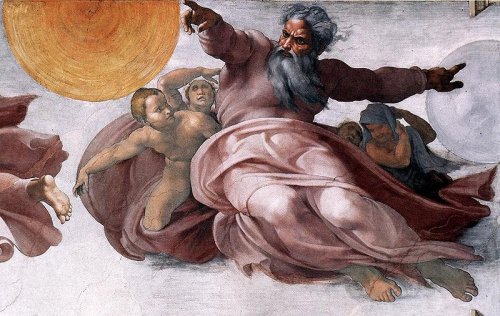
If God is infinitely just, he will punish wrongdoers.
If he’s infinitely merciful, he’ll forgive them.
Can he do both?
(Bonus palindrome: Did I do, O God, did I as I said I’d do? Good, I did!)

If God is infinitely just, he will punish wrongdoers.
If he’s infinitely merciful, he’ll forgive them.
Can he do both?
(Bonus palindrome: Did I do, O God, did I as I said I’d do? Good, I did!)
A whimsical traveler on one of the main trails in the State of Georgia painted, on a large rock, the words, ‘Turn Me Over.’ Other travelers heaved and struggled to turn the rock over. On the underside of it they found painted, ‘Now Turn Me Back That I May Fool Another.’
— H. Allen Smith, The Compleat Practical Joker, 1953
In 1913, German acrobat Otto Witte was traveling through the Balkans when Albania declared its independence from the Ottoman Empire. A fellow circus performer noted Witte’s resemblance to Prince Halim Eddine, whom a local faction were entreating to head the new state.
Witte maintained that he forged a couple of telegrams, arrived in the fledgling nation posing as Eddine, took control of the military, and was proclaimed king. For five days he disported with harem girls, ordered amnesty for prisoners, and distributed gold among the local chieftains. When inquiries began to arrive from Constantinople, he slipped out of town “to avoid unnecessary bloodshed.”
Skeptics note that this story is uncomfortably close to The Prisoner of Zenda, whose first film adaptation had appeared in that year. But Witte insisted the story was true, pointing to his official identity card, issued by the Berlin police, which listed his occupation as “circus entertainer” and “onetime king of Albania.” He seems to have convinced at least himself of the tale — when Witte died in 1958, Time noted that he would accept only mail that was addressed to “Otto I, ex-King of Albania.”
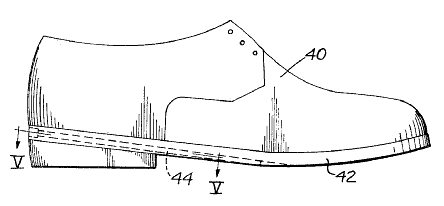
In 1971, Fred E. Stuart patented a “firearm mounted in a shoe heel.” He envisions military personnel and police using it when “regular weapons have been lost or become jammed.”
The shoes can fire regular bullets, frangible projectiles, or even tear gas, and can be fitted with multiple barrels that fire independently.
Combine this with a reversible sole and you have the makings of a perfect murder — a concealed weapon that confuses the crime scene.
The Cincinnati Gazette says that ‘William Marcy, a colored boy from Kentucky, who was in that city lately, can add up columns of figures of any length, divide any given sum, multiply millions by thousands within five minutes from the time the figures are given to him, and with such exactness as to render it truly wonderful. Recently, in the presence of a party of gentlemen, he added a column of figures, eight in a line, and one hundred and eighty lines, making the sum total of several millions, within six minutes. The feat was so astounding, and apparently incredible, that several of the party took off their coats, and, dividing the sum, went to work, and in two hours after they commenced produced identically the same answers. The boy is not quite seventeen years of age; he cannot read nor write, and in every other branch of an English education is entirely deficient.’
— The National Magazine, December 1853
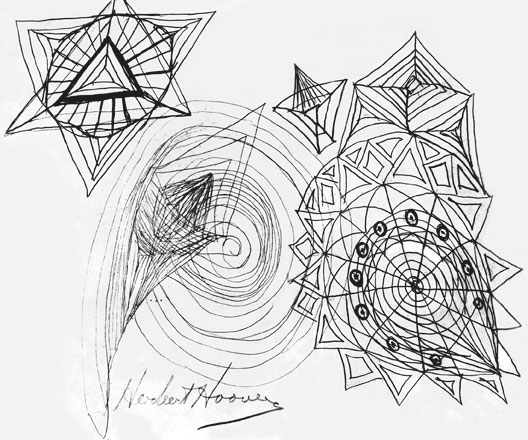
Herbert Hoover drew this doodle while being interviewed. When he tossed it in a White House wastebasket, a guest retrieved it and asked him to sign it. The guest then sold it to collector Thomas Madigan … who resold it for a substantial sum.
Thereupon the doodle was published in newspapers across the country, often with expert interpretations. “Generally this man is highly efficient, a man who figures things out and who is at his best tackling difficult tasks,” opined one for the Chicago Tribune. Another objected: “It is the normal thing for a man to do — to occupy himself scribbling with a pencil when talking over the telephone or listening to someone. It would be significant if the president did not do this.”
Before it was over, the doodle had been converted into a fabric pattern for children’s rompers, which even Hoover’s granddaughter was said to have worn. If the president had an opinion about all this, he kept it to himself.
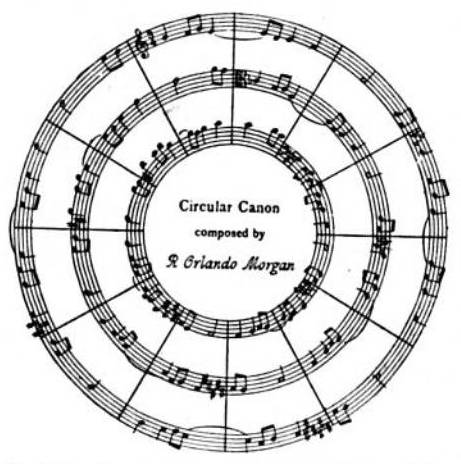
From Strand, August 1906:
A circular canon is so named not because of its circular form, but because it completes the circle of fifths–i.e., it goes through all the keys, each a perfect fifth above the other, until it returns to the original key. The one under notice is written in triple counterpoint, any part sounding equally well in the top, middle, or lowest voice, and each bar is in three different keys at once, all harmonizing.
This rendering is a bit indistinct, I’m afraid — if I can find a clearer version I’ll post it.
In the November 2010 Word Ways, Mike Keith notes a striking coincidence:
Bible’s Machine and Welding
6499 Blue Springs Pkwy
Mosheim, TN 37818
That’s the address of a machine shop in eastern Tennessee, presumably owned by a family named Bible. Enter the zip code in a calculator and turn it upside down.
In Nature, May 12, 1870, captain Charles Dennehy of the R.M.S. Shannon noted “a very curious phenomenon” observed by the occupants of iron vessels off the port of Grey Town, Nicaragua.
“[W]hile at anchor in this situation, we hear, commencing with a marvellous punctuality at about midnight, a peculiar metallic vibratory sound, of sufficient loudness to awaken a great majority of the ship’s crew, however tired they may be after a hard day’s work.”
The sound, Dennehy said, converted the ship into “a great musical sounding board.” “It is musical, metallic, with a certain cadence, and a one-two-three time tendency of beat. It is heard most distinctly over open hatchways, over the engine-room, through the coal-shoots [sic], and close round the outside of the ship. It cannot be fixed at any one place, always appearing to recede from the observer. On applying the ear to the side of an open bunker, one fancies that it is proceeding from the very bottom of the hold.” It continued for about two hours, was heard only aboard iron vessels, and was unknown to the inhabitants on shore.
Denney’s letter brought responses from readers who referred to similar sounds in Trinidad, India, and Chile. They postulated a “musical fish” or gas rising from vegetation on the seabed but offered no conclusive explanation.
Curiously, William Corliss notes that the sounds’ descriptions seem to match the Yellowstone Lake whispers.
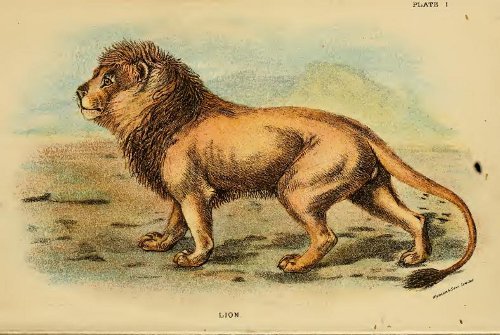
In 1938, the American Mathematical Monthly published an unlikely paper: “A Contribution to the Mathematical Theory of Big Game Hunting.” In it, Ralph Boas and Frank Smithies presented 16 ways to catch a lion using techniques inspired by modern math and physics. Examples:
The article has inspired a tradition of updates by other mathematicians over the years:
Dudley also suggested a “method of moral philosophy”: “Construct a corral in the Sahara and wait until autumn. At that time the corral will contain a large number of lions, for it is well known that a pride cometh before the fall.”